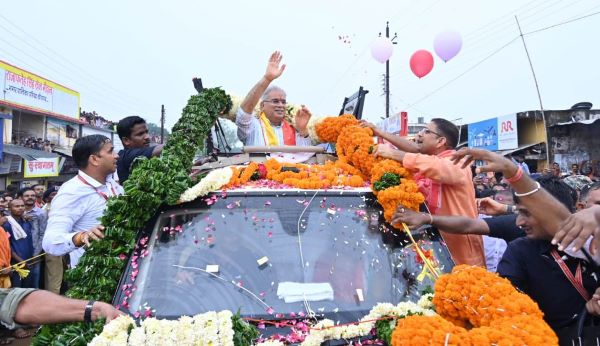
Team News Riveting
Raipur, September 3
With the launch of three newly formed districts in Chhattisgarh, the state that came into being in November 2000 now has a total of 31 districts.
At the time of inception, Chhattisgarh had 16 districts. Three new districts came into existence with the inauguration of the 29th district Mohla-Manpur-Chowki on September 2 by Chief Minister Bhupesh Baghel and two more new districts namely Sarangad-Bilaigarh and Khairagarh-Chhuikhdan-Gandai on 3rd September.
With this, Sarangarh-Bilaigarh became the 30th district of the state and Khairagarh-Chhuikhadan-Gandai became the 31st district. It is a historical achievement for the state of Chhattisgarh that in a span of two days, people have received the gift of three new districts. On the occasion of the inauguration of the newly formed districts, the enthusiasm and joy of the fulfilment of people’s age-old demands were naturally visible on the faces of the residents there. With the creation of these new districts, the access of the administration will be strengthened, due to which the development works in these areas will be done at a rapid pace.
It is worth mentioning that Chief Minister Bhupesh Baghel had announced the formation of new districts on the occasion of Independence Day on August 15, 2021, with the objective of tightening administrative work and providing convenience to the general public. Now with the launch of the districts, the Chief Minister has fulfilled the year-old demand and dream of the residents of these areas since the formation of Chhattisgarh.
The enthusiasm of the people was seen at its peak as soon as the Chief Minister arrived at the inauguration of the newly formed districts. A large number of people showered flowers on the Chief Minister and expressed their gratitude for the creation of the new district. To welcome the Chief Minister, youth took out a bike rally and school children performed folk dance. During the Chief Minister’s roadshow, long queues of people were seen on both sides of the road to welcome him. The Chief Minister was also weighed with traditional Chhattisgarhi dishes and fruits by various organizations. The Chief Minister congratulated and extended best wishes to the people of the district on the inauguration of the new districts.
Baghel said that he got unprecedented happiness from the decision to form a new district. It is evident how big a decision this was for the residents from the huge crowd present in the roadshow. He further said that ‘Chhattiagrh mahatari ke kora me Naya jila Jud ge hai’ and The dreams of the ancestors are taking shape.
Baghel, during the program organized at Mohla, Sarangarh and Khairagarh, along with the inauguration of newly formed districts, granted several development works worth Rs 1037.37 crore to the residents of the area. Chief Minister Baghel also inaugurated development works worth Rs.106 crore in Mohla-Manpur-Ambagarh Chowki, while Rs.931 crore 37 lakh was given for development and construction works in Sarangarh and Khairagarh. At the inauguration of Sarangarh-Bilaigarh district, he inaugurated development works worth Rs 512.29 crore and inaugurated development works worth Rs. 54.52 crore, while in the inauguration program of Khairagarh-Chhuikhadan-Gandai district along with development works worth Rs. 364 crore 56 lakh. Under various schemes of the government, material and grant-in-aid amounting to Rs 37 lakh 48 thousand were provided to 213 beneficiaries.
Newly formed district
Mohla-Manpur-Ambagarh-Chowki district is going to be carved out of Rajnandgaon district and now has been recognized as a new administrative unit. The new district is bounded by the Chhuria tehsil of Rajnandgaon in the north, Durgkondal and Pakhanjur tehsil of Kanker district in the south, Dondi and Dondi Lohara tehsil of Balod district in the east, and Maharashtra state in the west. The new district Mohla-Manpur-Ambagarh-Chowki will be under the Durg division. There are 3 tehsils in the newly formed district namely Ambagarh Chowki, Mohla and Manpur. Development Block and Janpad Panchayat are Ambagarh Chowki, Mohla and Manpur.
The total number of villages in this newly formed district is 499. The geographical area is about 2 lakh 14 thousand 667 hectares. The total population is 2 lakh 83 thousand 947. Out of these, the total population of the scheduled tribe is 1 lakh 79 thousand 662 which is 63.27 per cent of the total population of the district. There are 13 Revenue Inspector Divisions in the district, 89 Patwari Halka, and 185 Gram Panchayat. The total number of police stations in Mohla-Manpur-Ambagarh Chowki district is 9. The 2 assembly constituency comes under this district and the total polling station is 497. The distance from Rajnandgaon district to Ambagarh Chowki is 50 km, Mohla is 75 km, and Manpur is 100 km. This area has been affected by Naxal activities for a long time. With the creation of a new district, the administration will reach these areas closer and the pace of development works will increase. This area is full of natural forest wealth. Minor forest produce is abundant in dense forests. The Mohala-Manpur region is a tribal-dominated area.
Sarangarh, the district headquarter of the newly formed Sarangarh-Bilaigarh district, is located on Raipur to Raigarh National Highway No. 200 road. An airstrip has been located here since the time of the princely state. District Headquarter Sarangarh is the Tehsil Headquarter and Sub-Divisional Officer Revenue Headquarters before the formation of Chhattisgarh. The newly formed Sarangarh-Bilaigarh district includes the Sarangarh sub-division, Sarangarh and Baramakela teshil of Raigarh district which is a part of Bilaspur division and Bilaigarh sub-division and Bilaigarh Tehsil of Balodabazar-Bhatapara district which is a part of Raipur division. There are three tehsils namely Sarangarh, Baramakela and Bilaigarh and two sub-tehsils Kosir and Bhatgaon in the new district. The newly formed district consists of three Janpad Panchayats, Sarangarh, Baramkela and Bilaigarh. This newly formed district is bounded by Raigad in the north, Mahasamund district in the south and Bargarh of Odisha in the east and Baloda Bazar in the west and Janjgir-Champa district in the northwest. The newly formed district is home to a large number of people belonging to the Ramnami community. Mahanadi is the main river of the Sarangarh-Bilaigarh district. On the other hand, the Gomarda Sanctuary, located in the Sarangarh-tehsil of the district, easily attracts tourists. The Dussehra festival of Sarangarh is very famous like Bastar-Dussehra.
According to the 2011 census, the total population is 6 lakh 17 thousand 252. There are 759 villages, 349 gram panchayats, and 5 urban bodies. There are 20 Revenue Inspector Divisions which include Sarangarh, Hardi, Salar, Kosir, Chhind, Godam, Ulkhar, Baramkela, Gobarsingha, Devgaon, Dongripali, Sariya, Bilaigarh, Pawani, Govindavan, Jamgahan, Bhatgaon, Girsa, Bilaspur and Sarsiwa. The total revenue area is 01 lakh 65 thousand 14 hectare and 2518 is the number of revenue cases. At present, 1406 schools, 7 colleges, 33 banks, 3 projects, 141 health centres, 10 police stations and 2 outposts are established in the new Sarangarh-Bilaigarh district.
The population of the newly formed Khairagarh-Chhuikhdan-Gandai district is 3 lakh 68 thousand 444 which is a part of the Durg division now. There are 494 villages and 3 urban bodies, and two sub-divisions Khairagarh and Gandai-Chhuikhadan. There are three tehsils namely Gandai, Chhuikhadan, and Khairagarh, while two development blocks Chhuikhadan and Khairagarh, and 16 Revenue Inspector Divisions. There are 107 Patwari Halkas, 221 Gram Panchayats in this new district.
This new district is bounded by District Kabeerdham in the North, Tehsil Dongargarh in the South, Tehsil Rajnandgaon District- Rajnandgaon, Tehsil Saja District- Bemetara in the East, Tehsil- Dhamdha District Durg and Tehsil Lanji District- Balaghat (Madhya Pradesh) in the West. Khairagarh-Chhuikhadan-Gandai district is also rich in mineral resources, which will give impetus to industrial development.
The formation of a new district will bring major relief to the local residents, as they would no longer have to travel afar to get their work done. Administrative decentralisation will directly benefit the common people. Basic facilities such as education, healthcare, drinking water, and food supply will be expanded and made easily available to the people. Moreover, this would also help in the effective implementation of government public welfare schemes in remote areas. Enhanced road connectivity, the construction of bridges and culverts will make traffic movement in remote forest areas smooth and systematic. The formation of a new district will give good results in the coming years.



